Determining the Instrumental Delays of WAT-910BD (CCIR)
Abstract
A new integrating board video camera WAT-910BD from Watec was announced in Oct 2013 [1]. It has two times more sensitive sensor compared to the current WAT-910HX cameras and offers ability for external camera control via an SPI interface. In order to use the camera for timing of astronomical events with GPS inserted time, it is required the instrumental delay (G Dangl, [2]) to be known for the various integration modes the camera can operate in. This article discusses the determination of the instrumental delays of a CCIR WAT-910BD camera and demonstrates that the camera operates with the same instrumental delays as the previous WAT-910HX camera.Method
The camera was used to record the display of SEXTA [4] and the digital display of ADVS-HTCC [3], which were synchronised to UT using two separate GPS receiver and were controlled by separate micro controllers. The video from the camera was timed using IOTA-VTI [5] and was recorded using OccuRec [6] as an AVI file. The recorded files were then open and a frame for which the exposure had started shortly after the second mark has been selected. The integration delay was calculated from the determined optical exposure times derived from the lit LEDs of SEXTA and the inserted timestamp by IOTA-VTI.Equipment and Recording
The camera was attached to a FUJINON lens with F=14-70mm and operated at F/22. The camera was running in a specially built enclosure and was controlled via the hand operated remote controller. It was running at Gamma = 1, Gain = minimum and the AGL turned ON. For modes below x64 SEXTA was running in a 1 sec mode with a precision of 2ms.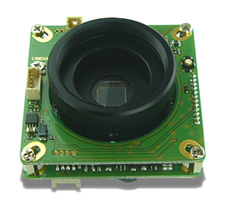
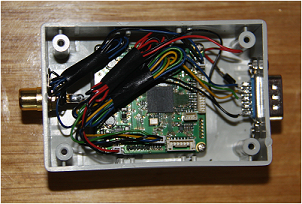
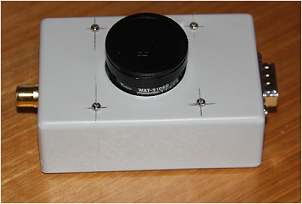
For exposures of x64 and above SEXTA was running in a 10 sec mode with a precision of 20ms. The image below shows the layout of the equipment being recorded during the experiment.
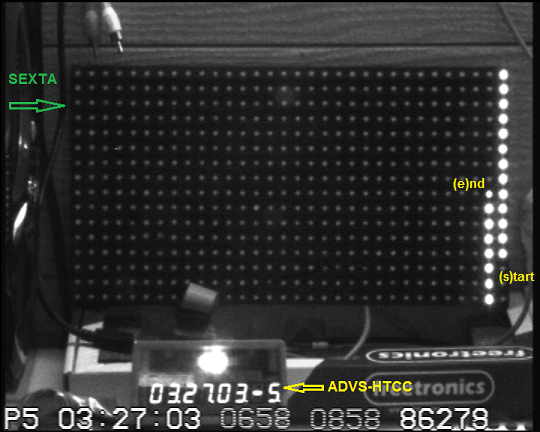
The recording was done in day light under the closed roof of Tangra Observatory. The GPS receiver of SEXTA was under unobstructed skyes at all times during the experiment.
Measurements
Below are the actual exposures selected and used to determine the instrumental delays for the various integration modes of WAT-910BD along with the computational notes.The full set of full resolution images in both video frame and video field mode are available for download from: InstrDelay910BD-ALL.zip (6.1 Mb). You can also click on the IE and x2 images below to see the full resolution video field image.
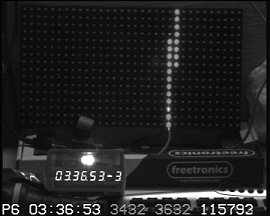
| Mode: | EI |
| Optical Exposure: | 304 ms - 344 ms |
| Optical Mid Time: | 324 ms |
| Exposure Timespan[*]: | 40 ms (1 fr - interlaced) |
| Embedded Time: | 323.2 ms - 363.2 ms |
| Embedded Mid Time: | 343 ms |
| Calculated Delay: | 19 ms +/- 2 ms |
| Claimed Delay: | 20 ms |
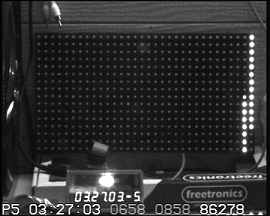
| Mode: | x2 |
| Optical Exposure: | 008 ms - 048 ms |
| Optical Mid Time: | 028 ms |
| Exposure Timespan: | 40 ms (1 fr - combined) |
| Embedded Time: | 045.8 ms - 085.8 ms |
| Embedded Mid Time: | 066 ms |
| Calculated Delay: | 38 ms +/- 2 ms |
| Claimed Delay: | 40 ms |
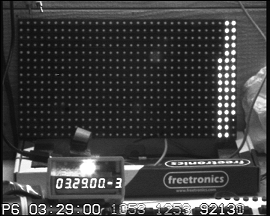
| Mode: | x4 |
| Optical Exposure: | 006 ms - 086 ms |
| Optical Mid Time: | 046 ms |
| Exposure Timespan: | 80 ms (2 frames) |
| Embedded Time: | 085.3 ms - 125.3 ms |
| Embedded Mid Time: | 105 ms |
| Calculated Delay: | 59 ms +/- 2 ms |
| Claimed Delay: | 60 ms |
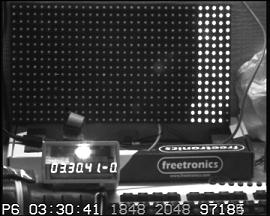
| Mode: | x8 |
| Optical Exposure: | 006 ms - 166 ms |
| Optical Mid Time: | 084 ms |
| Exposure Timespan: | 160 ms (4 frames) |
| Embedded Time: | 164.8 ms - 204.8 ms |
| Embedded Mid Time: | 185 ms |
| Calculated Delay: | 99 ms +/- 2 ms |
| Claimed Delay: | 100 ms |
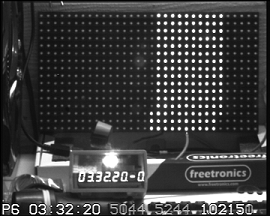
| Mode: | x16 |
| Optical Exposure: | 166 ms - 486 ms |
| Optical Mid Time: | 326 ms |
| Exposure Timespan: | 320 ms (8 frames) |
| Embedded Time: | 484.4 ms - 524.4 ms |
| Embedded Mid Time: | 504 ms |
| Calculated Delay: | 178 ms +/- 2 ms |
| Claimed Delay: | 180 ms |
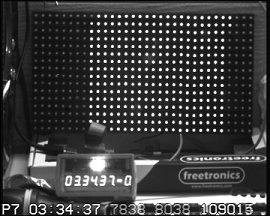
| Mode: | x32 |
| Optical Exposure: | 126 ms - 766 ms |
| Optical Mid Time: | 446 ms |
| Exposure Timespan: | 640 ms (16 frames) |
| Embedded Time: | 763.8 ms - 803.8 ms |
| Embedded Mid Time: | 784 ms |
| Calculated Delay: | 338 ms +/- 2 ms |
| Claimed Delay: | 340 ms |
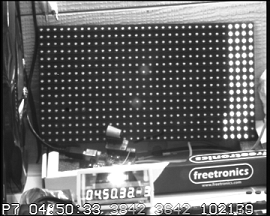
| Mode: | x64 |
| Optical Exposure: | 060 ms - 1340 ms |
| Optical Mid Time: | 700 ms |
| Exposure Timespan: | 1280 ms (32 frames) |
| Embedded Time: | 344.2 ms - 384.2 ms |
| Embedded Mid Time: | 364 ms (+1 sec) |
| Calculated Delay: | 664 ms +/- 20 ms |
| Claimed Delay: | 660 ms |
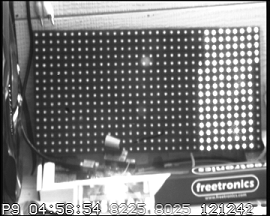
| Mode: | x128 |
| Optical Exposure: | 240 ms - 2800 ms |
| Optical Mid Time: | 1520 ms |
| Exposure Timespan: | 2560 ms (64 frames) |
| Embedded Time: | 782.5 ms - 822.5 ms |
| Embedded Mid Time: | 823 ms (+2 sec) |
| Calculated Delay: | 1303 ms +/- 20 ms |
| Claimed Delay: | 1300 ms |
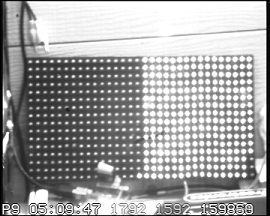
| Mode: | x256 |
| Optical Exposure: | 060 ms - 5140 ms |
| Optical Mid Time: | 2600 ms |
| Exposure Timespan: | 5080 ms (127 frames) |
| Embedded Time: | 139.2 ms - 179.2 ms |
| Embedded Mid Time: | 159 ms (+5 sec) |
| Calculated Delay: | 2559 ms +/- 20 ms |
| Claimed Delay: | 2560 ms |
In EI mode the camera works as a non-integrating camera exposing two video fields (20ms each) and then returning them in a combined interlaced video frame. In x2 mode the camera exposes for 40ms and returns two video fields exposed during the full 40ms interval. Those two fields will be transmitted separately and will be timestamped separately by IOTA-VTI. Thanks to Dave Gault for pointing out that more details are needed to show how the camera works in those two modes. The small screenshots above for those two modes now link to the full resolution field separated images that demonstrate exactly how the camera operates.
Conclusions
The WAT-910BD camera operates with the same instrumental delays as the WAT-910HX camera. The values in table below are for the WAT-910HX as published on Gerhard Dangl's web site [2].| WAT-910BD (CCIR) | |||||
| Mode | Integration time [s] | Correction time [s] | Tolerance value [s] | ||
| Evaluation in fields (0.020s) | Evaluation in frames (0.040s) | Evaluation in fields (0.020s) | Evaluation in frames (0.040s) | ||
| EI | 0.020 | -0.020 | -0.020 | ±0.010 | ±0.020 |
| x2 | 0.040 | -0.030 | -0.040 | ±0.020 | ±0.020 |
| x4 | 0.080 | -0.050 | -0.060 | ±0.040 | ±0.040 |
| x8 | 0.160 | -0.090 | -0.100 | ±0.080 | ±0.080 |
| x16 | 0.320 | -0.170 | -0.180 | ±0.160 | ±0.160 |
| x32 | 0.640 | -0.330 | -0.340 | ±0.320 | ±0.320 |
| x64 | 1.280 | -0.650 | -0.660 | ±0.640 | ±0.640 |
| x128 | 2.560 | -1.290 | -1.300 | ±1.280 | ±1.280 |
| x256 | 5.080 | -2.550 | -2.560 | ±2.540 | ±2.540 |
References
[1] WAT-910BD - a New and More Sensitive Integrating Video Camera, http://www.asteroidoccultation.com/observations/NA/2013Meeting/2013Presentations.htm[2] G. Dangl, Video exposure time analysis from recordings with video time insertion, http://www.dangl.at/ausruest/vid_tim/vid_tim1.htm
[3] T. Barry, H. Pavlov, D. Gault, Astronomical Digital Video System (ADVS), http://www.hristopavlov.net/ADVS/
[4] T. Barry, D. Gault, Southern EXposure Timing Analyser (SEXTA), http://www.hristopavlov.net/ADVS/pdf/ADVS-Manual-G_TimeValidation.pdf
[5] IOTA-VTI, http://videotimers.com/
[6] OccuRec, http://www.hristopavlov.net/OccuRec
Hristo Pavlov, 9 November 2013